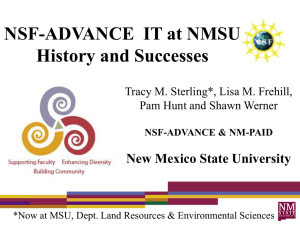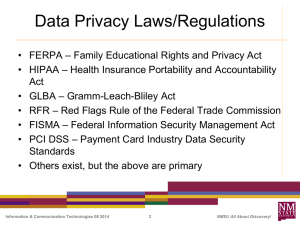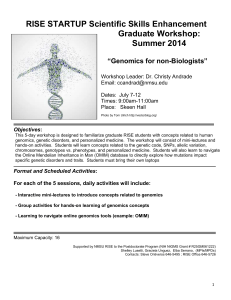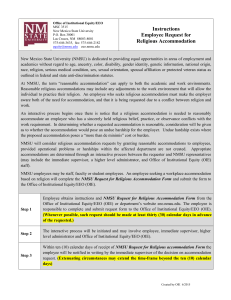Side-by-side analysis of the Insight into Diversity report
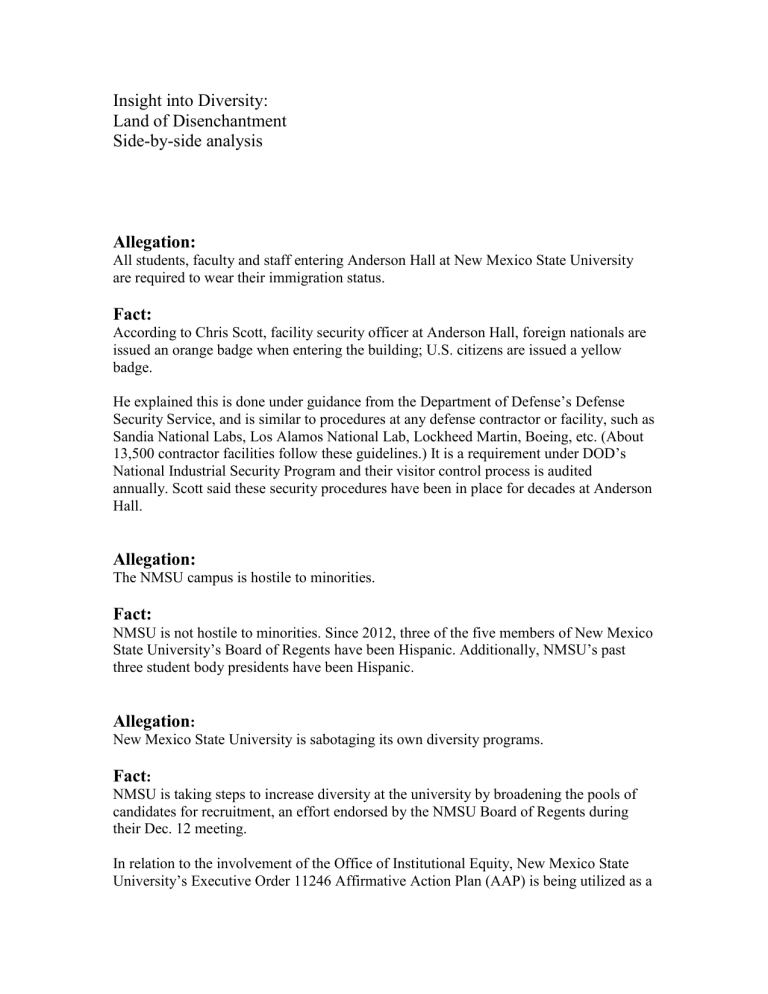
Insight into Diversity:
Land of Disenchantment
Side-by-side analysis
Allegation:
All students, faculty and staff entering Anderson Hall at New Mexico State University are required to wear their immigration status.
Fact:
According to Chris Scott, facility security officer at Anderson Hall, foreign nationals are issued an orange badge when entering the building; U.S. citizens are issued a yellow badge.
He explained this is done under guidance from the Department of Defense’s Defense
Security Service, and is similar to procedures at any defense contractor or facility, such as
Sandia National Labs, Los Alamos National Lab, Lockheed Martin, Boeing, etc. (About
13,500 contractor facilities follow these guidelines.) It is a requirement under DOD’s
National Industrial Security Program and their visitor control process is audited annually. Scott said these security procedures have been in place for decades at Anderson
Hall.
Allegation:
The NMSU campus is hostile to minorities.
Fact:
NMSU is not hostile to minorities. Since 2012, three of the five members of New Mexico
State University’s Board of Regents have been Hispanic. Additionally, NMSU’s past three student body presidents have been Hispanic.
Allegation :
New Mexico State University is sabotaging its own diversity programs.
Fact :
NMSU is taking steps to increase diversity at the university by broadening the pools of candidates for recruitment, an effort endorsed by the NMSU Board of Regents during their Dec. 12 meeting.
In relation to the involvement of the Office of Institutional Equity, New Mexico State
University’s Executive Order 11246 Affirmative Action Plan (AAP) is being utilized as a
live working document to assist with providing employees and applicants with equal employment opportunities within our university system. This includes our community colleges and cooperative extension divisions.
Positive good faith efforts will be expected of everyone but particularly of those in a supervisory position who are responsible for recruiting, interviewing, and hiring. As stated in NMSU’s AAP, “NMSU believes that not only is equal employment opportunity the law, it is the right and fair way to counteract past discrimination and unequal opportunity.” This will be in combination with the change of the College Deans now having the oversight of the hiring and recruitment of new faculty within their particular disciplines. The College Deans strive to take positive recruitment efforts to assure the entry and growth of minorities and women into NMSU’s workforce.
NMSU will also be developing relationships with outside entities to recruit, hire, promote, and retain individuals with disabilities and protected veterans. This will also assist with
NMSU maintaining compliance with Section 503 of the Rehabilitation Act of 1973, as amended (Section 503) at 41 CFR Part 60-741 and implementing the Vietnam Era
Veterans’ Readjustment Assistance Act, as amended (VEVRAA) at 41 CFR Part 60-30 which requires employers to take affirmative action to improve job opportunities.
Allegation:
NMSU’s faculty lacks diversity.
Fact:
As part of NMSU’s strategic plan, Vision 2020, the university has identified a number of goals and key performance indicators (KPIs) to judge whether the goals are being met.
Goal 2 for Vision 2020 covers diversity and internationalization. Specifically, NMSU will provide a diverse academic environment supportive of a global society.
According to KPI 7, New Mexico State University has the second most diverse faculty of our peer institutions, behind only the University of Texas at El Paso.
Additionally, the most recent Performance Effectiveness Report of New Mexico
Universities lists NMSU as having 15.5 percent Hispanic faculty. The University of New
Mexico is listed at 12.1 percent and New Mexico Tech as 6.7 percent.
According to President Carruthers, the issue with faculty diversity nationwide is that there are small pools of diverse candidates from which many universities are searching.
While he was New Mexico’s governor, Carruthers helped to start a program where the state would support minority students who left the state to earn their Ph.D. in exchange for the student returning to New Mexico to become a university professor.
Allegation:
Hispanic faculty members are leaving NMSU in great numbers.
Fact:
The number and percentage of Hispanic faculty members at NMSU has actually gone up
(+23, +2%) in the past three years while the number and percentage of white faculty members has declined (-66, -7%).
Allegation:
The Office of Student Diversity and Outreach has been closed down
Fact:
The Office of Student Diversity and Outreach has not been closed down. While the position of assistant vice president for student diversity and outreach will not be refilled following the retirement of Christina Chavez Kelley, the functions handled by that office continue today, including the work done by Black Programs, Chicano Programs and the
American Indian Program. The Sexual and Gender Diversity Resource Center is also still in operation.
Importantly, NMSU considers these programs vital for student recruitment and retention and the heads of Black Programs, Chicano Programs, Student Gender and Resource
Center and the American Indian Program now report directly to NMSU’s vice president for student affairs and enrollment management and are part of her leadership team.
Allegation:
Christina Chavez Kelley filed an eight-page, single-spaced grievance against NMSU.
Fact:
New Mexico State University’s Human Resources Department investigated the grievance filed by Christina Chavez Kelley. The investigation turned up no findings – none of her
allegations were substantiated. The complainant, apparently disappointed in the outcome of her grievance, has taken her case to the public.
Allegation:
NMSU’s Diversity Council was disbanded shortly after Christina Chavez Kelley retired.
Fact:
NMSU’s Diversity Council was actually reinstated by President Garrey Carruthers shortly after he became president. The council is still in existence to this day.
“The Council has not been disbanded,” said Alisa C. Gonzalez, chair of the NMSU
Diversity Council, in a Faculty Talk post on Nov. 21. “We apologize for the lack of communication over the summer and this fall semester. But, it would have been appropriate for the author of the article to confirm with the Chair or Chair-Elect as to whether the Council had been disbanded.”
Faculty Talk is an internal listserv for NMSU faculty members.
Allegation:
President Carruthers refused repeated invitations to speak with the Diversity Council.
Fact:
Carruthers did not refuse invitations to speak with the Diversity Council. He was responsible for reinstating the Diversity Council and has met with the group’s leadership multiple times. He has never been invited to meet with the council in its entirety.
“While several members expressed their desire for President Carruthers to speak to the group, as Chair I never extended a formal invitation to him,” said Alisa C. Gonzalez, chair of the NMSU Diversity Council, in a faculty talk post from Nov. 21. “Therefore, he could not have refused an invitation to meet with the Council ‘three times.’”
Faculty Talk is an internal listserv for NMSU faculty members.
Allegation:
Discrimination is rampant at NMSU.
Fact:
Over the past five fiscal years, only two discrimination complaints at NMSU that were investigated by outside bodies have resulted in findings. The vast majority of complaints investigated by these outside bodies result in no findings.
Allegation:
New Mexico State University is not doing enough to address diversity issues.
Fact:
At the request of NMSU’s Diversity Council, President Carruthers agreed to finance a climate survey for the university. The survey, using a modified version of a Noel-Levitz instrument, was conducted during the fall 2014 semester and was released this month.
The survey of over 1440 faculty and staff measured employee satisfaction in 40 separate areas, including campus culture and policies, institutional goals and involvement in planning and decision-making. Of all 40 areas measured, the survey results show that
NMSU faculty and staff are relatively satisfied on diversity issues. The “gap” between the importance faculty and staff place on diversity and the job they feel the university is doing in the area was the smallest of any measured and, under Campus Culture and
Policies, “NMSU places a high emphasis on having a diverse faculty and staff” had the
4 th
highest satisfaction score of the 40. The 3 rd
highest satisfaction score was for “NMSU has a clear policy and a process for reporting discrimination”.
Additionally, a recent survey of more than 1,900 NMSU graduates showed that Hispanic graduates had a higher level of satisfaction with NMSU than their non-Hispanic counterparts.
Statistically significant differences in ratings are indicated by *.
Allegation:
NMSU’s recent change in admission requirements hinders the chances of diverse students to be admitted.
Fact:
At New Mexico State University, student success is key. Unfortunately, not every student who graduates from high school is prepared to begin a successful career as a university student. The new admission requirements are meant to help students who may encounter academic trouble at NMSU by allowing them to first begin earning college credits at one of NMSU’s community colleges. In these smaller classroom environments, students are more likely to succeed and may later transfer to NMSU, a possibility that has been enhanced by the development of an Aggie Pathway to the Baccalaureate. The Faculty
Senate voted 34-11 to support this measure.
The proposed change in admission requirements would not impact diversity at
NMSU. University leaders have looked carefully at this issue and there will be no significant change in the percentage of Hispanic students, and students of other minority groups, should the GPA required for admission rise to 2.75. About 56 percent of students who entered NMSU in fall 2013 were Hispanic and 9 percent were American Indian,
Asian American, Black Hawaiian Pacific single races or multiple races. Students entering
NMSU in fall 2013 also were approximately 54 percent female. Had these new requirements been in effect at the time, these numbers would be nearly the same.

